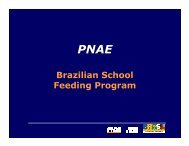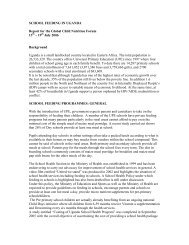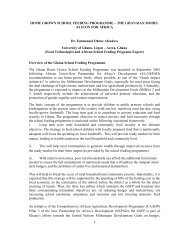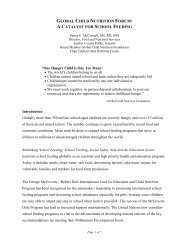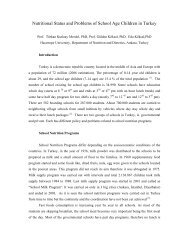EXECUTIVE SUMMARY - Global Child Nutrition Foundation
EXECUTIVE SUMMARY - Global Child Nutrition Foundation
EXECUTIVE SUMMARY - Global Child Nutrition Foundation
Create successful ePaper yourself
Turn your PDF publications into a flip-book with our unique Google optimized e-Paper software.
Scaling Up Sustainability: Linking School Feeding with Agriculture<br />
Development to Maximize Food Security<br />
May 3-7, 2011<br />
Nairobi, Kenya<br />
Feedback Reports: Tier I and Tier II Countries<br />
■ Speakers: Penny McConnell, GCNF<br />
Stanley Garnett, GCNF<br />
Lydie Mukashyaka, Delegate from Rwanda<br />
Delegates from Cameroon, Cape Verde, Ethiopia, Ghana, Kenya, Liberia, Liberia, Mozambique, Tanzania, Uganda,<br />
and Zambia<br />
Overview<br />
The School Feeding Toolkit developed by GCNF provides a<br />
framework for assessing a country’s current situation and developing<br />
a country plan. Many countries have successfully used this<br />
toolkit to develop a plan and to guide their implementation of a<br />
school feeding program.<br />
For delegates that had not previously been exposed to this<br />
Toolkit, most view government commitment and political will as<br />
the most important target, and lack of funding for school feeding<br />
as their greatest challenge. Their key indicators include<br />
developing a legal framework and a national policy for school<br />
feeding.<br />
For delegates from countries that have experience using this<br />
toolkit, many have made significant progress. They have<br />
developed policies, gotten government support, and in some<br />
instances, have had success in getting the government to budget<br />
for school feeding.<br />
Context<br />
Penny McConnell described GCNF’s School Feeding Toolkit.<br />
Delegates then divided in groups based on their tier. After<br />
developing country goals and objectives, as well as identifying<br />
challenges and barriers, the delegates reconvened and reported<br />
back the key points of their plans.<br />
Key Points (School Feeding Toolkit)<br />
GCNF’s School Feeding Toolkit is an instrument to<br />
assess needs and plan sustainable food programs.<br />
GCNF developed this Toolkit about 12 years ago. The<br />
purpose of the Toolkit is to help countries develop plans for<br />
sustainable school feeding programs. The Toolkit assists<br />
countries in assessing their current situation, setting priorities,<br />
identifying resources, and determining the capacity that is<br />
needed.<br />
This Toolkit is flexible and adaptable. It is suitable for use at<br />
any level (national, provincial, or regional). It gives countries<br />
ownership for their goals and is available in multiple<br />
languages.<br />
The Toolkit’s country-planning process consists of five steps:<br />
1. Country Goals and Objectives. This step entails<br />
defining the school feeding program’s goals and<br />
objectives. The process for establishing goals should be<br />
collaborative and involve multiple stakeholders<br />
including ministry representatives, teachers and school<br />
foodservice providers, and parents.<br />
© 2011 GCNF and PCD. All rights reserved. Page 32<br />
2. Diagnostic Information. This entails answering numerous<br />
questions such as: the current status of school<br />
feeding; school attendance; the nutritional status of<br />
school-age children; the commitment and infrastructure<br />
for school feeding; and the capacity of the food supply<br />
for school feeding. These answers will affect the school<br />
feeding plans.<br />
3. Needs Assessment. Each country must evaluate its<br />
capacity and commitment to implement school feeding.<br />
The needs assessment entails looking at several<br />
targets and indicators that show an area’s schoolfeeding<br />
needs.<br />
4. Country Plan. Based on the needs that are identified, a<br />
country plan can be developed.<br />
5. Country Plan Revision and Feedback. A country plan is<br />
never final. It is constantly evolving and being revised,<br />
which is why the diagram below is a continuous circle.<br />
Based on their experience using the Toolkit, countries are<br />
thought of as Tier I or Tier II.<br />
Tier I countries have never completed a workshop using the<br />
Toolkit and therefore don’t yet have a country plan. At this<br />
Forum, delegates from Tier I countries focused on Step 1,<br />
developing country goals and objectives. Tier II countries have<br />
used the Toolkit and have a country plan. Delegates from<br />
these countries spent their time at this Forum reviewing their<br />
progress, goals, and challenges. (In some situations, a country<br />
might have previously developed a school feeding plan, but<br />
the delegates were unfamiliar with the Toolkit and attended<br />
the Tier I sessions.)



